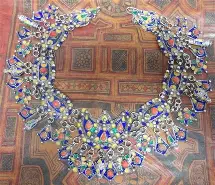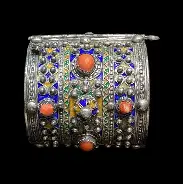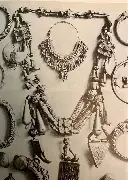In the rugged mountains of Kabylia, northern Algeria, silver gleams with meaning. Each Kabyle Berber jewelry piece is not merely decorative it is a silent language, encoding ancestral wisdom, spiritual beliefs, and social identity. Passed down through generations, these intricate designs tell stories of protection, fertility, and tribal belonging, preserving a cultural heritage that has resisted centuries of change.
Today, we delve into the hidden symbolism of Kabyle jewelry, exploring how these “metal amulets” function as both art and armor for the Amazigh (Berber) women who wear them.
The Craftsmanship: Silver, Symbols, and Sacred Geometry
Kabyle jewelry is traditionally handcrafted by Berber silversmiths, using filigree, engraving, and coral inlays. Unlike the gold preferred in Arab North Africa, Kabyle pieces are almost always made of silver, believed to have purifying and protective qualities.
Key techniques include Filigree, delicate wirework symbolizing the interconnectedness of life. Repoussé, hammered relief designs representing strength. Coral and enamel red coral, a sacred material, wards off the evil eye

Sacred Geometry and Cosmic Symbols
Every curve and pattern holds meaning. Triangles mean femininity, the three phases of the moon, Diamonds, and zigzags mean fertility, water, and agricultural abundance. Solar motifs mean divine protection, eternity. The Hand of Fatima (Khamsa), deflects evil, but in Kabyle style, is distinctly geometric.
Kabyle jewelry often functions as talismanic armor. Necklaces or Tizerzai are heavy silver collars with layered pendants that shield the wearer’s vital energy. Fibulae (Tizerzai or Tizegzarin), brooch-like clasps fastening cloaks, shaped like butterflies or birds, symbolizing freedom and the soul’s journey. Earrings (Tikhutin or Ijjan), bell-shaped drops, ward off malevolent spirits with their sound.
Quite significantly, a newborn might receive a small silver bracelet to guard against illness, for Marriage, Brides wear elaborate headdresses known as Asebbu and chest plates, signaling fertility and prosperity. Jewelry is often simplified or darkened, reflecting a change in status.
It also denotes Social Hierarchy and Tribal Identity. Specific designs denote: Wealth represented with (more intricate filigree = higher status), Region (coastal Kabyle vs. mountain motifs differ slightly), Lineage (some patterns are clan-specific)
Though Kabyle people are predominantly Muslim, their jewelry preserves pre-Islamic Amazigh spirituality. Even Islamic symbols like the Khamsa (Hand of Fatima) are reinterpreted through a Berber lens more abstract, less figurative.

Wearing the Ancestors’ Wisdom
Kabyle Berber jewelry is a metal archive of memory. Each piece is a map of identity, a shield against harm, and a celebration of womanhood. In a globalized world, these jewels remain a defiant statement: “We remember who we are.”














